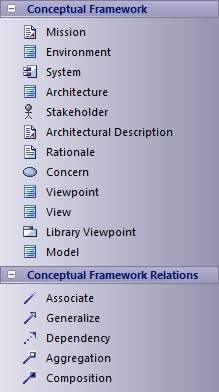| Prev | Next |
Conceptual Framework Toolbox Pages
The Conceptual Framework Elements are used to model the architectural descriptions and to establish concepts for architectural thinking. The Toolbox element design is based on IEEE standard 1471 - 2000.

Conceptual Framework Toolbox
Item |
Description |
|---|---|
|
Mission |
Captures the mission statement, policies and values of the enterprise. Tagged Value – ID |
|
Environment |
Defines the developmental, operational and programmatic context of the system for the purpose of Enterprise Engineering work. Tagged Value – ID |
|
System |
Captures details of a working component of the enterprise. System includes, for example, application, system, platform, system -of-systems, enterprise and product line. Tagged Value – ID |
|
Architecture |
Captures the definition of the Architecture work. Tagged Value – ID |
|
Stakeholder |
Captures the actors interested and involved in the enterprise. Tagged Value – ID |
|
Architectural Description |
Captures the architectural descriptions and identifies the system’s stakeholders and their concerns. Tagged Value – ID |
|
Rationale |
Captures the statement of purpose for the Architectural Description. |
|
Concern |
Forms the basis for completeness. An Architectural Description addresses all stakeholders’ concerns, and each Concern is addressed by an Architectural View |
|
Viewpoint |
A Pattern for constructing Views – Viewpoints define the rules on Views. Each View corresponds to exactly one Viewpoint. Tagged Value – ID |
|
View |
A representation of a whole system from the perspective of a set of Concerns. A View can contain one or more architectural models, so the View can use multiple notations. |
|
Library Viewpoint |
Captures a collection of categorized Viewpoints. Tagged Value – ID |
|
Model |
Defines and represents a model. Tagged Value – ID |
Notes

